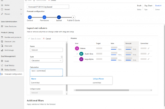The increasing online presence in terms of streams of revenue and reputation of individuals and businesses has been accelerated by the ongoing COVID-19 pandemic. Unfortunately, online fraud has also been on a positive trend due to this. Statistically, over $6 billion has been spent by e-commerce businesses to shelter shopper’s accounts from fraud, and the number is expected to triple in the next few years. For this reason, it is becoming increasingly important to protect your streams of revenue against fraud.

Dynamics365 Fraud Protection was introduced specifically to enable you to protect your online revenue stream and your reputation. This solution was initially, dedicated to preventing payment fraud. Subsequent release waves based on customer feedback have added capabilities to this solution. They include preventing:
- Creation of fake accounts.
- Taking over accounts.
- Fraudulent access to accounts.
Dynamics365 Fraud Protection employs account and forensics data to track down fraudulent account creation especially from bots. It also employs adaptive AI to assess fraud during the most important steps of creating accounts permitting account blocking before fraudulent activity. The latest release wave (October 2020 release) of Dynamics365, contains information on the added capabilities of this solution, which will be discussed here.
Enhanced Onboarding and User Experience
For the customers, D365 has added feature-specific guided tours that simplify navigation through the solution. The tours explain the cases in which a feature in the solution is applicable and how to get started with the feature. In an attempt to further simplify navigation, new groupings for features and assessments have been introduced to enable you to uncover meaningful information intuitively. For a given assessment, there exist features that are specific for it represented as tabs. Features are distinguished into data and settings. Data encompasses what is required to explore it, ingress and egress while settings include service-management-related features. This addition grants you the knowledge of when, how, and why you would use Fraud Protection.
Manual Review
In the age of increasing automation of online transactions, there is a need for a human review to reduce the risk of fraud. D365 Fraud Protection’s “Manual Review” provides you with an opportunity to augment fraud protection. It allows you to identify transactions that you would prefer to review manually, queue them, and amplify the review process. The Manual Review feature allows you to do the following.
- Customers can specify criteria that subject fraudulent transactions to queues for manual review. Workflows may play a vital role; they can be triggered when a criterion is surpassed and a sequence of events that line up the transaction for review is initiated. Power apps (such as Power Automate) can be used to generate these workflows.
- A review dashboard has been introduced where customers can manually analyze a fraud pattern.
- This addition allows customers to create consequent actions on the incidence of fraud.
- This version comes with a customized dashboard displaying multiple orders affiliated with fraud (such as review orders, false-positive rate, etc.).

Enhancement to Rules
D365 Fraud Protection allows you to assign names to clauses i.e. clause naming. Clauses are sections of rules expressing options for different strategies to be followed on different incidences of fraud. The clause names can appear in the rule and in the Applied Programming Interface response. Clause naming provides a name to a specific triggered response alongside the response itself.
Customer Offer
In the latest release wave, the Microsoft Dynamics365 license has set up a limited capacity of assessments for a given period. For purchase protections, account protection, and loss prevention up to 2000, 20000, and 8000 assessments can be completed without an extra charge respectively. If assessments exceed the numbers stated above, the customer has no option but to pay extra.
This solution is still being improved with subsequent release waves targeting more capabilities.



